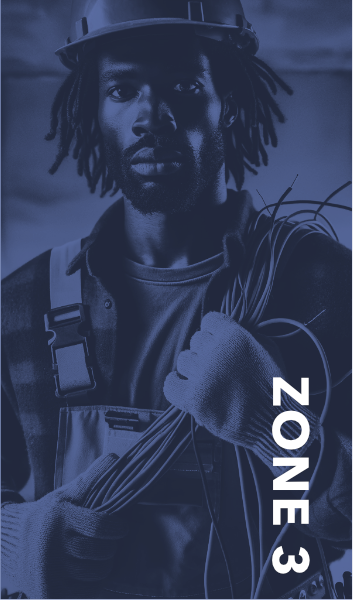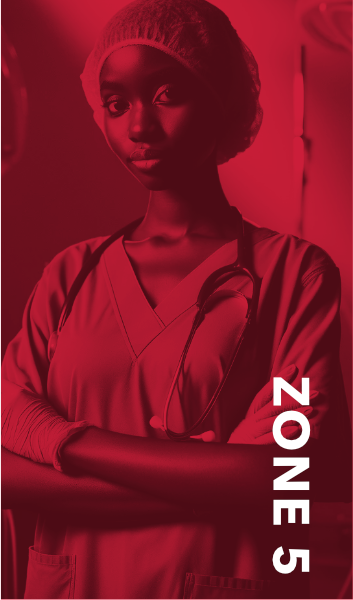Decoded Pathways
vocational cartography
I recently started to investigate how occupations were connected and the role education plays in the journey of those in the Black community. Can we use today's data to help others focus on knowledge and skills that will help them shift careers? As someone who works in education, I know the effort that goes into mapping curriculum to real-world scenarios and the daunting debt students acquire while pursuing their dreams. In a time when the basics needed to survive come at a cost, there's more pressure to take more calculated risks with a clear return on investment.
Photo by Brad Neathery on Unsplash
Unified Career Comparisons
To have a consistent approach for comparing different job positions, creating an index of shared professions, and determining the essential educational background required to start a professional journey, I grouped the Standard Occupational Codes (SOC) from the Bureau of Labor Statistics into broader categories. These categories were based on shared abilities, interests, work styles, and values described in the Department of Labor's Occupational Information Network (ONET). By using more than ten years of completion data from the Department of Education's Integrated Postsecondary Education Data System (IPEDS), I could summarize the number of graduates related to each SOC group. The Current Population Survey (CPS) data, jointly sponsored by the U.S. Census Bureau and the U.S. Bureau of Labor Statistics (BLS), provided insights into the labor force in each major SOC category. These new SOC profiles revealed labor force figures for each sector, further divided by race, salary, and average degrees by level.

Clerks
This career profile highlights jobs that require little preparation, such as taxi drivers, amusement attendants, clerks, animal caretakers, machine operators, and waiters/waitresses. These jobs don't need prior work-related skills or experience. While a high school diploma might be necessary, on-the-job training is emphasized. Successful candidates need skills such as attention, flexibility, strength, and speed. Other necessary attributes include a conventional approach, attention to detail, dependability, social orientation, and the ability to support others. These roles are suitable for entry-level candidates who enjoy hands-on experience and direct interactions.

Salespeople
This profile covers careers that require preparation, such as sheet metal workers, forest firefighters, customer service reps, physical therapist aides, retail salespersons, and tellers. They need work-related skills, knowledge, or experience and typically require a high school diploma. On-the-job training usually lasts a few months to a year, and some have apprenticeship programs. These jobs require skills like dynamic flexibility, spatial orientation, gross body coordination, and peripheral vision. Personal attributes like conventional and enterprising approach, self-control, social orientation, and relationship-building are also beneficial. These careers provide opportunities for those motivated by helping others and thrive on direct interaction and service.

Makers
This is a career profile for positions that require moderate preparation, such as electricians, legal secretaries, and medical assistants. These roles usually require previous work experience, skills, or knowledge. They often involve communication and organizational skills to coordinate, supervise, manage, or train others to achieve goals. Professionals in these fields are expected to possess a broad range of abilities, including auditory attention, depth perception, problem sensitivity, deductive and inductive reasoning, mathematical reasoning, multi-limb coordination, and various forms of vision. Personal characteristics necessary for success in these roles include analytical thinking, attention to detail, initiative, innovation, and persistence. These careers are ideal for individuals with artistic, investigative, and realistic inclinations, offering a balance of challenges and rewards.

Specialists
This career profile covers diverse professions such as accountants, sales managers, database administrators, teachers, chemists, art directors, and cost estimators. They require significant work-related skills, knowledge, and experience. These roles usually require a bachelor's degree and strong organizational, leadership, and cognitive skills. Personal attributes essential for these roles include analytical thinking, attention to detail, initiative, innovation, and persistence. These occupations appeal to individuals with artistic, conventional, and investigative inclinations, offering a blend of challenges and rewards.

Healers & Professionals
This career profile covers specialized professions, such as sports medicine physicians, wildlife biologists, school psychologists, surgeons, librarians, lawyers, treasurers, and controllers. These professions require advanced degrees and extensive experience. Professionals in these fields must demonstrate proficiency in various abilities, including communication, organization, and reasoning skills. Furthermore, these occupations require personal attributes such as adaptability, analytical thinking, attention to detail, integrity, leadership, persistence, and stress tolerance. They attract individuals with an investigative, realistic, and social orientation who are motivated by a blend of personal fulfillment and professional accomplishment.
Hierarchy of Labor Systems
ONET groups occupations into zones representing a particular hierarchy of positions from entry-level to executives. The six categories are the root, with job zones and expertise types moving outward from the center. The angle of each arc corresponds with the number of occupations associated with each category. I also subdivided jobs into two groups (e.g., Workers and Experts) based on unique abilities. About half of the professions fall under the Professionals and Makers category, representing various zones in that type of work with a split of Workers and Experts. Other occupational groups need more diversity of zones or expertise.
Employment Among Blacks
Based on the data, most of our community holds jobs in Maker and Professional occupations. Most individuals work in Zone 2 within the Maker category, while a more minor proportion work in Zones 4 and 5. As for the level of skills applied, it tends to lean towards the Worker category. In the Professional group, our occupations are distributed across various zones, aligning with the overall distribution of jobs in that segment, except for Zone 3, where we hold a small portion of Expert jobs. Most people in the Black community are generally employed in Zone 2 occupations.
Correlation Between Job Zones and Wages
Based on Bureau of Labor Statistics (BLS) jobs associated with Department of Labor job zones, the following chart shows the average annual wages earned for each job zone. The data is sorted based on the job zone and wage in ascending order. In most instances, the average wage increases as the zone increases. Some zones share average wages, but there is a clear split between Zone 3 and 4.
Mapping Career Progression
Exploring the links between various occupational paths and visualizing these relationships became a focal point. The goal was to craft a career progression map tailored to show different transition points between job levels, spotlighting the various potential paths with more application of abilities and compensation. A process was constructed, tapping into multiple ONET datasets, encompassing knowledge, skills, activities, context, zones, and descriptions. This data flow also draws upon ONET's career change methodology to identify the top ten occupation alignments for all jobs.
Photo by Guilherme Cunha on Unsplash
Knowledge Across Job Zones
This chart shows the level of importance of each knowledge category across the five job zones. The goal was to identify highly valued knowledge across all zones and see where importance varies. The most critical knowledge is related to the English language, customer and personal service, education and training, and mathematics. The knowledge that increases with zones tends to be related to administration and management, computers and electronics, administration, public safety, and security. The knowledge that tends to decrease as the zone increases includes things related to psychology, production and processing, mechanicals, law, and government.
Skills Across Job Zones
This chart shows the level of importance of each skill category across the five job zones. The goal was to identify highly valued skills across all zones and see where importance varies. The most essential skill set is active listening, critical thinking, reading comprehension, speaking, and monitoring. Skills that increase with zones are related to judgment and decision-making, writing, complex problem-solving, and social perceptiveness. Skills that decrease as the zone increases include programming, installation, operations monitoring, quality control analysis, operation and control, troubleshooting, equipment selection, maintenance, and repair.
Activities Across Job Zones
This chart shows the level of importance of each activity category across the five job zones. The goal was to identify highly valued activities across all zones and see where importance varies. In this instance, there was no consistent activity across all zones. Essential activities in Zone 1 are not in Zone 5; the opposite is true. The space between zone 2 and 3 is where the most transition in activity importance occurs.
I started my career as a dishwasher at Checkers. However, today, I develop systems that help people with education administration. Given my humble beginning, no one could have predicted I would reach where I am today. Is there a path in data that I could follow? That's when I used the Department of Labor's change algorithm to identify potential paths to lead to Job Zone 5. Unfortunately, there wasn't any logical path, but one possible route was Dishwasher to Short Order Cook, Library Technician, Online Merchant, and Operations Research Analyst. Looking back, I did work at McDonald's, flipping burgers. While studying and searching for jobs, I relied heavily on the local library's computer stations. I also dabbled in e-commerce as it was emerging. I am most connected with the Library Technician role of all the occupations on the path. Working in that position could have ignited my interest in information design and architecture earlier. That's where formal education helps. It allows one to change one's path without needing to work in prerequisite occupations. I found my way by switching to the path of an artist/designer, which introduced me to education science; from there, I learned about data analysis and visualization. Educators have always had a special place in my heart.
Educational milestones
Some occupations require extensive preparation. I naturally became interested in the educational requirements for various job levels, identifying schools that offer related credentials, examining the number of Black students who receive them, and exploring the areas where we tend to obtain the highest levels of education. I studied educational requirements from ONET and IPEDs completion data from 2010 to 2021. This analysis facilitated the visualization of degrees by several demographic variables associated with their respective occupational codes and awards.
Photo by Soundtrap on Unsplash
Hierarchy of Educational Systems
Given the Department of Education's college completion data, I clustered the degrees offered for the last ten years into six categories using the CIP codes, connecting each degree to a group of occupations. Most degrees fall into the professional category and focus on zones 3, 4, and 5. According to ONET, jobs associated with zones higher than 2 require a formal credential as an education requirement. Most degrees are also associated with the maker and professional space.
Degrees Awarded Among Blacks
I focus on the degrees awarded to Black students for the last ten years in this chart. Most are related to the Maker space and job Zone 2 occupations. Professionals is another area where we obtain a lot of credentials associated with job Zones 3 and 4. If you remember the previous employment chart, I pointed out how few Black people are applying abilities as experts in Zone 3. This chart shows we have the educational experience to qualify for those jobs. It's also worth noting that many of our degrees are associated with jobs that do not require extensive training and preparation.
Correlation Between Job Zone and Education Requirements
Based on the Department of Labor's education requirements for each job zone, this chart shows the proportion of credentials required by level. The data is sorted based on the proportion of education needed in descending order. Job Zone 1 typically requires less than a high school diploma, while Job Zone 2 mostly requires a high school diploma. Job Zone 3 is divided among various education levels. Job Zone 4 mostly requires a bachelor's degree, and Job Zone 5 is divided among higher education levels.
If you can learn, you can change.
When your options seem limited, the visualizations above serve as a reminder that you have many paths to follow. There may not be a logical transition in the data to the end goal, but there's enough data to point to the next possible step. That may or may not include higher education, especially if you want to increase your pay without incurring more debt. There are some core knowledge and skills you can practice developing now to help you transition across all the job zones. Not only do we live in a time when information is more available, but we now have tools to synthesize it into succinct answers if we know how to ask the right question.
As an experiment, I began researching how to leverage LLMs to provide a way to explore potential career and education opportunities.
Photo by Brad Neathery on Unsplash
Credits
Landing and Ending photo by Brad Neathery on Unsplash
Mapping Career Progression photo by Guilherme Cunha on Unsplash
Education Benchmarks photo by Soundtrap on Unsplash
National Center for O*NET Development. O*NET 28.1 Database. O*NET Resource Center. Retrieved November 30, 2023, from https://www.onetcenter.org/database.html









